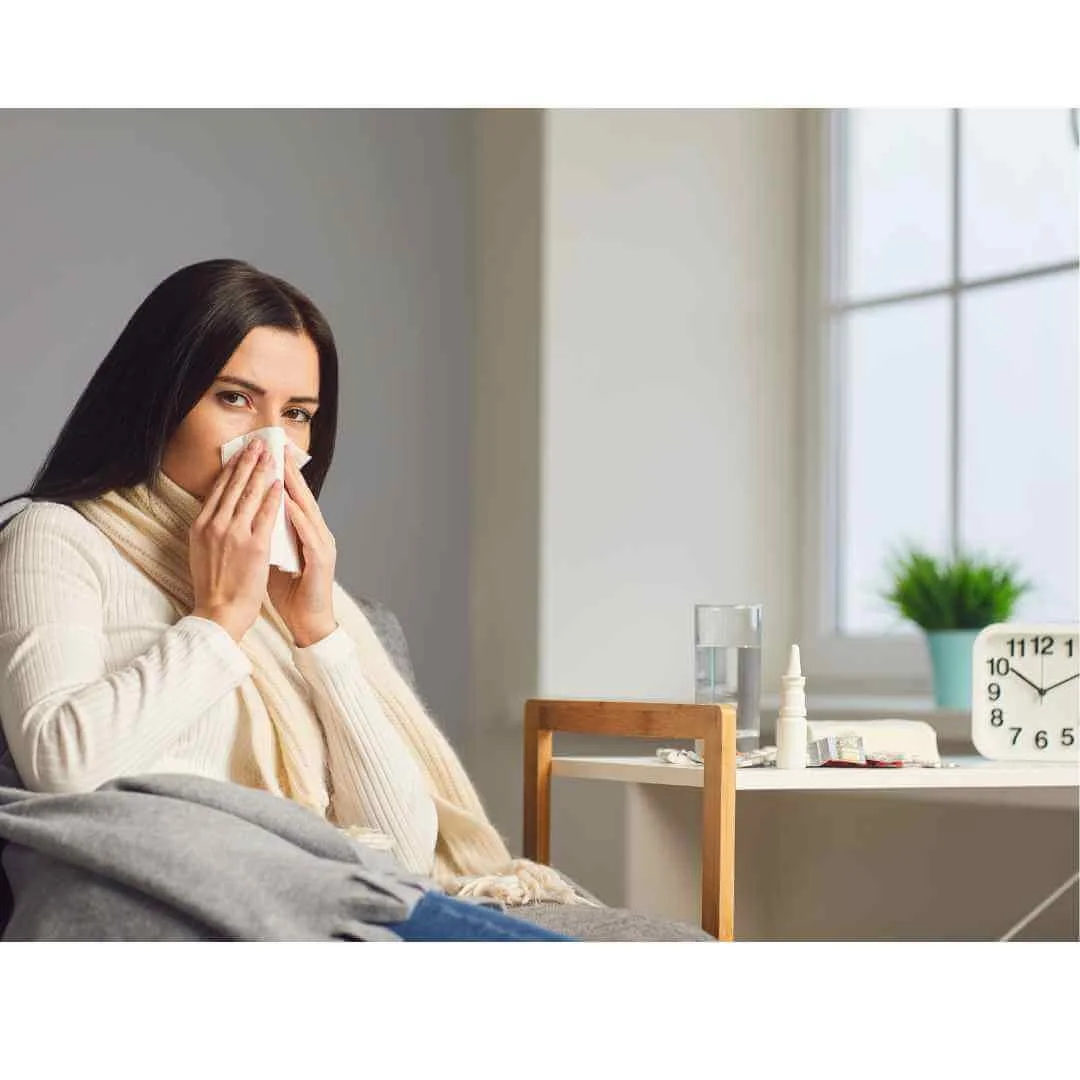The Sneaky Ways Mold Toxicity Affects Your Health Over Time and How to Take Charge
Understand how exposure to mold impacts your immune system and why you should take it seriously
Have you ever stopped to think about the air you breathe inside your home?
Air pollution is something we usually think of as being a problem outside or in big cities. But let’s not overlook the air quality in the place where you spend most of your time – your home.
Indoor air pollutants like:
Smoke
Vapors
Molds
Chemicals
Dust
…and more are found in paint, furniture, and cleaning products. They dirty the air you breathe and impact your health and well-being. Sometimes without you even knowing it.
Mold toxicity is a silent troublemaker that often lurks unseen and can seriously mess with your health and damage your immune system.
I'm Dr. Martina Sturm, and in this blog, we're diving deep into the world of mold toxicity. I'm unveiling its hidden threats and emphasizing the often-overlooked long-term effects it can have on your body. We’re also going to explore how functional medicine can be your trusty guide in navigating the maze of mold-related health concerns.
Let's start by understanding how mold impacts your health and wreaks havoc on your immune system.
Understanding Mold Toxicity
Mold is a fungus. While many fungi can have health benefits, some can cause infections (mycosis), allergy-like symptoms, and other toxic effects.
Mold can be found in multiple environments, both indoors and outdoors.
Air
Soil
Plants
Animals
Food
Humans
It usually grows in places with lots of moisture and must be inhaled, ingested, or enter the body through your skin.(1)
Mycotoxins are harmful toxins produced by mold. They can cause severe health problems in people and long-term illnesses. The two most common mycotoxins are aflatoxin and ochratoxin.
Other common mycotoxins are:
Fumonisms
Citrinin
Gliotoxin
Deoxynivalenol
Trichothecenes
Zearalenone
Patulin (2)(3)
While some people can naturally remove these toxins from their bodies, others can’t. If you’re one of those people who can’t naturally detox – you’re at risk for developing a number of health concerns, from allergies to cancer.(2)
The Long-Term Effects of Mold Exposure
The most common symptoms of mold exposure are symptoms you associate with allergies – like coughing, itchy and watering eyes, and a runny nose. But in some cases, the symptoms of mold toxicity can affect your entire body.(4)
They can cause and/or worsen many common health conditions like asthma, digestive disorders like irritable bowel syndrome, and systemic inflammation.(5)
The inflammation caused by mycotoxins can:
Cause breathing problems
Damage your gut microbiome by killing good bacteria
Wear down your immune system fueling allergies
Trigger Chronic Fatigue Syndrome
Overload your liver and lead to cancer
Impair brain function (3)
Mold and its mycotoxins mutate rapidly, making it hard for your immune system to fight off and weaken it over time. This can cause a variety of diseases directly related to mold exposure.
Balkan Nephropathy
Bronchitis
Internal Bleeding
Hepatocellular carcinoma
Organ failure
Kashin-Beck disease
Chronic respiratory infections
Reye’s syndrome (5)
The consequences of mold exposure and the long-term effects of mold toxicity can be severe. If you’re wondering whether your symptoms are related to the harmful effects of mold – your first step is to undergo testing and find the root cause of your symptoms.
How to Diagnose Mold-Related Illness
Mold and other toxins are literally found everywhere. So how do you know if your symptoms are related to mold or other toxins?
Common symptoms of mold exposure include symptoms of Mast Cell Activation Syndrome:
Coughing
Wheezing
Itchy eyes
Itchy skin
Sore throat
Allergies
Other symptoms can include:
Brain fog
Fatigue
Insomnia
Anxiety/depression
Memory loss/confusion
Vertigo
Yeast/fungal infections
Digestive issues (gas, bloating, nausea, vomiting, constipation, diarrhea)
Dark circles under eyes
Visual disturbances
Palpitations/racing heart beat
Tinnitus
Food or chemical sensitivities
Numbness/tingling
Tremors
Sweet/alcohol cravings
Sensitivity to light or sound
Migraines
Protruding veins
And more…
But going by your symptoms alone is not enough. It’s vital to complete an in-depth questionnaire that covers your symptoms (as they relate to mold exposure) and includes questions about your living and working environments, lifestyle, and diet.(6)
Functional lab testing is also needed to understand the level of mold toxicity in your body. Tests like:
Mycotoxin Urine Test
Complete Blood Count with Differential
Complete Metabolic Panel
Stool Testing
Mitochondrial Function
Glutathione Status
Liver Function Testing
DUTCH Cortisol Hormone Test
Visual Contrast Sensitivity Testing (7)
Functional lab testing combined with a thorough interview are key to identifying the underlying causes of your symptoms. This understanding helps create a roadmap to restoring your health and vitality.
Mold is not something you can fix with a pill or a one-time treatment. And sometimes the path to recovery can be long. But by working with a mold expert and approaching your path to healing from multiple angles, you can feel better. (4)
Address the Root Cause of Mold Toxicity With Functional Medicine
Your number one priority when treating mold toxicity is removing mold from wherever possible. This means addressing:
Your Environment
I’m talking about the places where you spend most of your time – where you work and your home.
To heal from mold toxicity your number one priority must be removing yourself from the moldy environment. It’s impossible to improve your health if you stay in a place where you’re constantly exposed to these toxins.
Mold thrives where moisture and water are present. You must fix the water and moisture problem in your home. If you don’t, then the mold problem (and your exposure to mold) will only get worse.(8)
Dust is another major mold attractant. This means keeping your surfaces, baseboards, and underneath surfaces dusted. Other less obvious measures include:
Using a high-quality air filter, like AirDoctor
Changing your HVAC filter monthly
Periodic air duct cleanings
Opening windows daily
Vacuuming frequently
Removing dust collecting items or storing items in cabinets
Removing carpets
If mold is a serious issue for you, it’s best to hire a certified mold inspector and a professional remediation service while temporarily moving out of your home. Once the mold is removed from your home, it’s vital to take an active role in preventing future mold growth.(4)
Your Diet
Eating a diet that’s low in sugar and additives is important when helping your body heal from mold toxicity. Packaged, processed, and other foods laced with mold and yeast promote fungal growth and make your symptoms worse.(9)
The list of foods to avoid can be complicated. Reach out to a mold expert to help you find where mold might be hiding in your diet.
Some foods that are generally safe to eat are:
Organic poultry
Wild-caught fish
Grass-fed/finished meats
Leafy greens
Raw nuts and seeds
Organic vegetables
Spices and herbs
Healthy fats
Beverages free from sugar and artificial sweeteners (9)
Eating a diet consisting of nutrient-dense whole foods is key to helping your body naturally detox and heal from mold toxicity.
Your Body
When you’re chronically exposed to mold and other toxins, your body’s natural detoxifying ability is overwhelmed. Mycotoxins and other heavy metals keep accumulating and add stress to your immune system. Your symptoms worsen, inflammation rises, and the possibility that you may develop an autoimmune disease increases.
But there are ways you can naturally rid your body of these toxins:
Avoiding further exposure to water-damaged environments.
Glutathione helps to remove free radicals from your body and is a powerful antioxidant made naturally inside your body.
Sequestering agents that bind to toxins and prevent them from being absorbed into the bloodstream. Binders such as clay, activated charcoal, chlorophyll, chlorophyllin, and cholestyramine can all help you rid your body of the toxins related to mold. (4)(10)
Antioxidants and other nutritional agents like melatonin, licorice extract, and vitamins A, C, and E.
Probiotics help restore balance inside your gut microbiome.
Sweating out toxins in your body through exercise or the use of infrared saunas and red light therapy. (10)(11)
Ozone Therapy is a powerful oxidant that promotes healing at the cellular level for a multitude of ailments and diseases including mold toxicity.
Eliminating your exposure to mold and boosting your body’s natural ability to detox is key in helping you heal from the devastating symptoms and diseases caused by mold toxicity.
To help you diagnose if your symptoms are related to mold exposure and find a path to healing – you need to work with someone who is a mold expert.
Achieve Holistic Well-being With Functional Medicine in Denver, Colorado
I know you may be feeling confused or overwhelmed. And it’s hard to know how or where to start. At Denver Sports and Holistic Medicine – I’m here for you. I partner with you, and together, we’ll create a personalized plan to help you achieve optimal health.
As a Certified Mold Practitioner, I can help you navigate your path to healing from mold toxicity.
To get started, request a 15-minute complimentary consultation with me, Dr. Martina Sturm.
It’s time to start feeling better.
Resources:
https://www.jillcarnahan.com/2015/02/08/toxic-mold-exposure-cause-symptoms/
https://www.sciencedirect.com/science/article/abs/pii/S1047965122000365?via%3Dihub
https://drlauryn.com/wellness-knowledge/how-to-test-for-mold-illness/
https://www.epa.gov/mold/brief-guide-mold-moisture-and-your-home
https://worthyselfcare.com/infrared-sauna-for-mold-toxicity/

